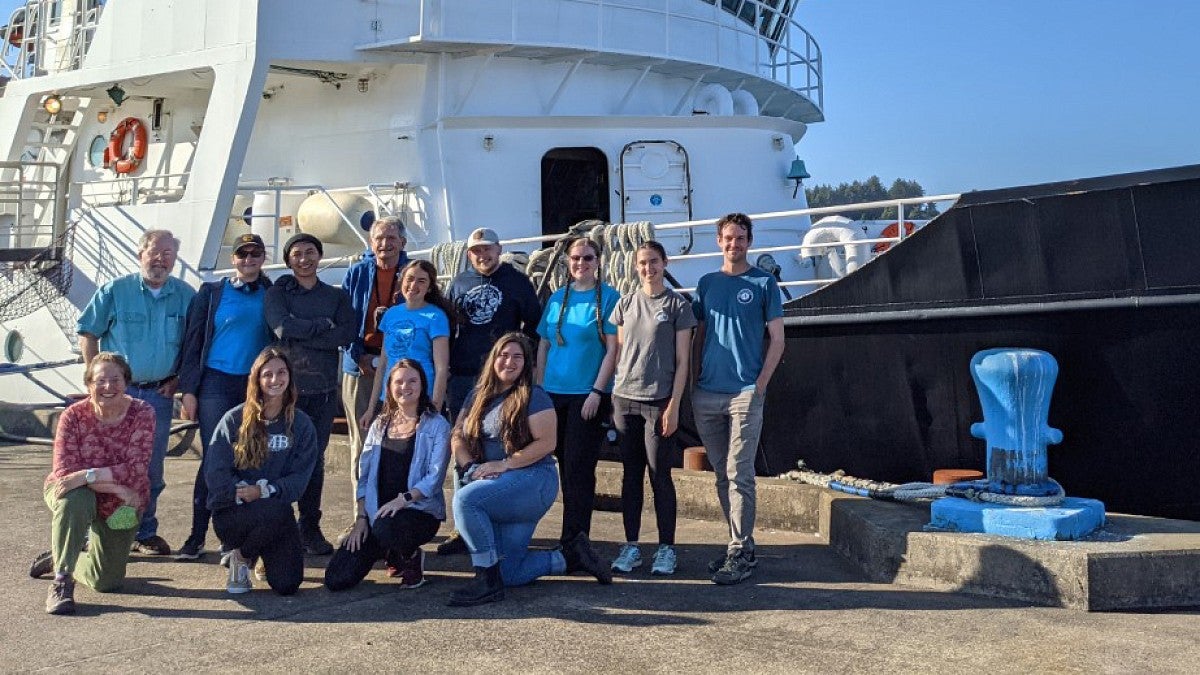Craig Young was leading a research trip off the Oregon coast near Newport Aug. 28 when he said he had the “strong impression” the ship should change course to collect samples in a new area.
It may have inadvertently been a lifesaving decision.
Young, director of the University of Oregon Institute of Marine Biology, and other OIMB staff and students were aboard the research vessel Oceanus when the ship’s crew responded to an emergency call from a sinking fishing boat that night, rescuing a fisherman who had deployed in a life raft.
The Oceanus crew “acted quickly and saved the man ... from almost certain death,” Young said. “Because of our change in sampling sites, we were, fortuitously, in the right place at the right time.”
Young was leading a team of UO students and visiting scientists on a project to catalog the diversity of invertebrates on the Oregon continental shelf for a project funded by the state. They were aboard the 177-foot Oceanus, owned by the National Science Foundation and operated by Oregon State University in a research partnership with the UO.
Earlier in the day, Young had decided to change course off the coast near Newport, playing a hunch the team could maximize the samples collected by trawling at a new spot.
They traveled two to three hours and were working at about 9:30 p.m. when a nearby commercial fishing vessel sent out a mayday distress call. The Lanola, out of Coos Bay and captained by Frank Akers, was sinking fast, overwhelmed by a series of waves. Akers, who was alone on the boat, told the Newport News Times he had heard a crash and suspected one of the waves may have hidden a log that slammed into the ship.
In steep, 15-foot seas, 35-mph winds and pitch-black night illuminated only by ship lights, Oceanus Capt. Jeremy Fox quickly suspended the science operation, and with all equipment out of the water guided the Oceanus alongside the life raft. His deck crew threw a grapple that hooked to a line on the raft and then lifted aboard Akers, in shock and suffering mild hypothermia, to be rushed to Newport for emergency care.
“There were huge waves. I watched as many waves came over the Oceanus and knocked down some of the sailors,” Young said. “The conditions were extremely difficult, about as bad as any I’d ever tried to work in.”
Caitlin Plowman, a doctoral candidate focusing on marine biology, was helping recover the last trawl of the day when she and the rest of the research team were ordered to discontinue work and gather inside the Oceanus.
“The PA system came on and it was the captain saying that we were going to rescue someone from the water — ‘This is not a drill. This is not a drill,’” Plowman said. “We were all just huddled in the main lab, looking out the windows. And then we saw a person climb over the side of the boat, the crew wrapped him up in blankets, brought him inside and gave him dry clothes and warm food. It was just 10 minutes from ‘This is not a drill’ to that man is on the boat and safe.”
Akers was grateful for his rescuers but devastated by the loss of his boat. “I wanted to go down with her,” he told the newspaper.
Young, too, was thankful for what he called the “absolutely incredible” Oceanus crew and an act of heroism that highlighted an otherwise fruitful three-day research cruise.
The OIMB team is creating an online book, “Oregon Shelf Invertebrates,” that is a guide to sponges, sea anemones, crustaceans and other sea life in the deeper waters off Oregon.
Most of the contributions are written by undergraduate marine biology majors as an ongoing, intergenerational class project. It serves not only OIMB marine biology students but also fisheries managers, federal and state agencies, conservationists, fishermen, scientists, and interested members of the public, Young said.
Between the fateful research trip, earlier expeditions and a recent intensive “bioblitz” that catalogued more than 800 species in the shallow waters near OIMB, Young said, the institute is greatly increasing the understanding of the biological diversity off Oregon.
For example, a single rock collected from the ocean floor more than doubled the known number of species of bryozoans — small but important animals — in Oregon, Young said, while adding more than 20 species new to science.
—By Matt Cooper, University Communications


